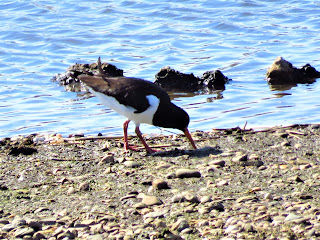My reason for visiting was to see two species that are not easy to see in Shropshire – Avocet and Little Ringed Plover. The other notable feature is a very active – and noisy – Black-headed Gull colony
There are reed-beds and plenty of scrubby areas to attract the smaller birds and some well-placed feeders providing great viewing and photographic opportunities
Apart from the Avocets and Little Ringed Plovers the only other summer visitors that had arrived were Chiffchaffs and Blackcaps with a pair of Barn Swallows overhead
So here are some of my photos from the day
Now here’s a thing. A drake Gadwall with the white speculum and chestnut wing patch ...?
But wait: what’s that with him? a duck Mallard.
If we look closely there is the hint of a white neck ring and chestnut collar.
A fine study of the bird.
The drake Tufted Ducks were having trouble with the slight breeze that sprang up.
Certainly a bad-hair day (though some TV personalities seem to want to emulate this as ‘fashion’).
This immature Cormorant did nothing apart from some desultory preening.
A Little Grebe in Summer plumage apparently looking for inspiration in the heavens.
Avocets are so elegant so there will be many shots.
Here we see a bird feeding with the characteristic sweeping motion.
They even look elegant standing on one leg.
A bit of a dispute ...
A lot of a dispute as two pairs charge. Very delicate bills.
And a single on the warpath?
Probably not – it has diverted for some food.
And another ...
... and going the other way.
... coming in for splash-down.
See: they can walk on water!
This one dipping to pick up something from the surface of the water.
This one ‘on finals’ for a hard landing.
Now this a good trick – landing on a post.
Oops.
Romance in the air for the Black-headed Gulls. Not usually as silent as this.
But then this pair seemed to be sulking.
Or is it a ploy?
Wings spread like this is partly territorial and partly a mating ritual.
More noise.
Like many birds (and humans!) the ‘feeding ritual’ is an important bonding activity.
Don’t look so solemn!
This pair look more mournful than solemn.
This pair are getting on better: the gulls nearby not interested on voyeurism apparently.
They certainly are noisy when they are enjoying themselves.
There are all manner of things one could say about this mating attempt: probably best left unsaid.
I never can resist Long-tailed Tits ...
A female Greenfinch. Look a lot more benign than the male with its dark mask.
A fine female Reed Bunting.
And again.
Spring at last? The ‘pussy willow’ looking great against the cobalt sky.
In reality catkins of a number of different willow trees (Salix sp.).
















































